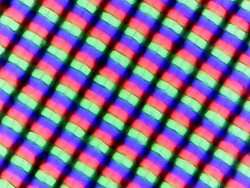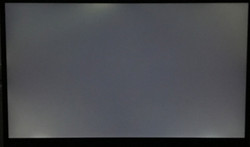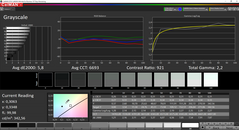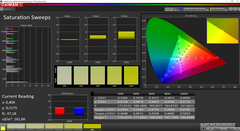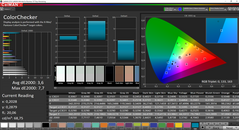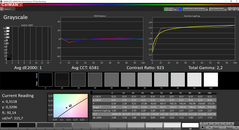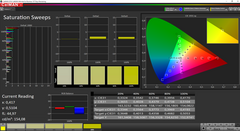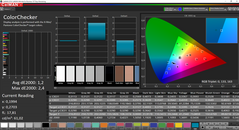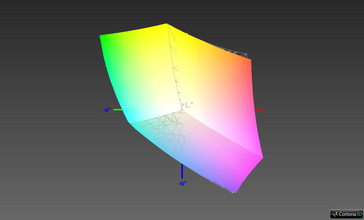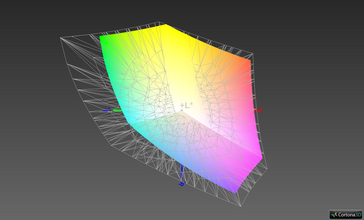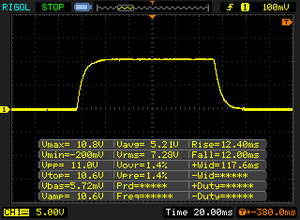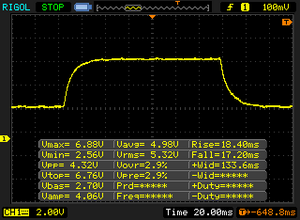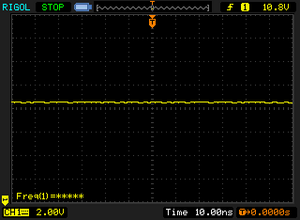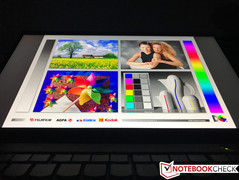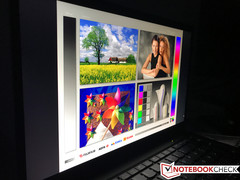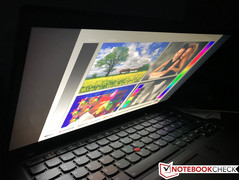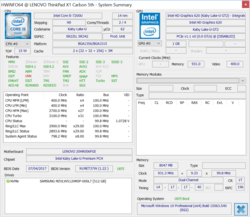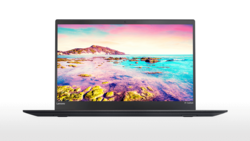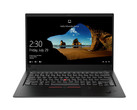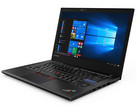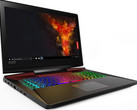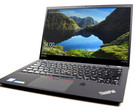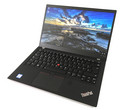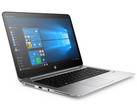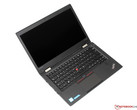Display Check: Lenovo ThinkPad X1 Carbon 2017 (i5, WQHD) Laptop
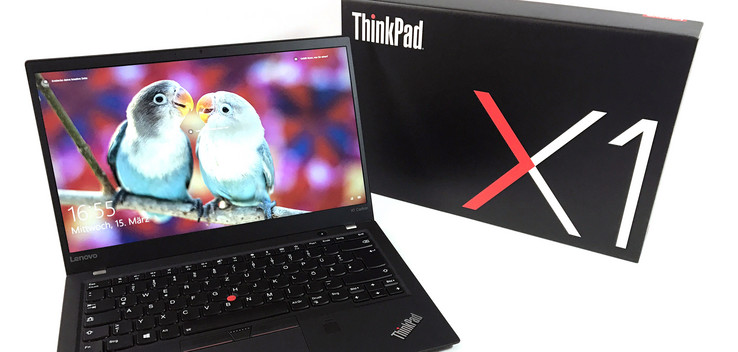
For the original German article, see here.
It has been about 5 months since the 5th generation of the ThinkPad X1 Carbon (2017) was launched. Lenovo now starts to sell SKUs with the high-resolution WQHD screen as well. We have already reviewed two 2017 models and the two 1080p screens were decent, but some users might have been slightly disappointed considering the premium price tag.
Our test model today carries the designation ThinkPad X1 Carbon 2017-20HR006FG3 and currently retails for ~2000 Euros (~$2348). As well as the previously mentioned WQHD screen, you will get a Core i5 processor, 8 GB of RAM and a 512 GB PCIe-SSD. The high-resolution screen is a $100 upgrade in Lenovo's online store. We have already tested the 2017 X1 Carbon twice, so in this article we will focus on the new display and the effect on the battery runtime. All other information about the other sections are available in the following two articles:
Display
Unlike the previous 2016 model of the ThinkPad X1 Carbon, the parts list shows only one WQHD panel from LG Philips. The panel lottery was a big annoyance for many customers last year since the LG Philips panel was supposedly superior compared to the screen from Panasonic, which was also the screen from our old test model.
It seems that Lenovo has listened to the criticism, because the current Kaby Lake X1 Carbon (WQHD) is only available with the LG Philips panel with the designation LP140GQ2-SPB1, and our measurements actually show some improvements over last year's model with the Panasonic screen. It starts with the PWM regulation, because we cannot determine a flickering screen at any brightness level. Only a minor backlight bleeding at the edges affects the good impression a bit, but they are only really noticeable at the highest brightness level. Another positive aspect is the low minimum luminance at just 4.6 cd/m², which is particularly important for dark environments.
| |||||||||||||||||||||||||
Brightness Distribution: 87 %
Center on Battery: 340 cd/m²
Contrast: 924:1 (Black: 0.37 cd/m²)
ΔE ColorChecker Calman: 3.6 | ∀{0.5-29.43 Ø4.78}
ΔE Greyscale Calman: 5.8 | ∀{0.09-98 Ø5}
98.5% sRGB (Argyll 1.6.3 3D)
68.8% AdobeRGB 1998 (Argyll 1.6.3 3D)
74.5% AdobeRGB 1998 (Argyll 3D)
98.4% sRGB (Argyll 3D)
73.5% Display P3 (Argyll 3D)
Gamma: 2.2
CCT: 6693 K
| Lenovo ThinkPad X1 Carbon 2017-20HR006FGE LEN40AA (LP140QH2-SPB1), , 2560x1440, 14" | Lenovo ThinkPad X1 Carbon 2017-20HR0021GE B140HAN03_1, , 1920x1080, 14" | Lenovo ThinkPad X1 Carbon 2017-20HQS03P00 B140HAN03_1, , 1920x1080, 14" | Lenovo ThinkPad X1 Carbon 20FB003RGE VVX14T058J00, , 2560x1440, 14" | Lenovo ThinkPad X1 Carbon 20FB-005XUS 1920x1080, 14" | |
|---|---|---|---|---|---|
| Display | -14% | -15% | -7% | -18% | |
| Display P3 Coverage (%) | 73.5 | 61.6 -16% | 61.4 -16% | 66.7 -9% | 58.9 -20% |
| sRGB Coverage (%) | 98.4 | 87.6 -11% | 85.9 -13% | 94.7 -4% | 83.1 -16% |
| AdobeRGB 1998 Coverage (%) | 74.5 | 62.6 -16% | 62.4 -16% | 68.4 -8% | 60.3 -19% |
| Response Times | -36% | -29% | -16% | -28% | |
| Response Time Grey 50% / Grey 80% * (ms) | 35.6 ? | 48 ? -35% | 41.6 ? -17% | 44 ? -24% | 47.2 ? -33% |
| Response Time Black / White * (ms) | 22.4 ? | 30.4 ? -36% | 31.6 ? -41% | 24 ? -7% | 27.6 ? -23% |
| PWM Frequency (Hz) | 220 ? | ||||
| Screen | 9% | -6% | 5% | 4% | |
| Brightness middle (cd/m²) | 342 | 278 -19% | 311 -9% | 272 -20% | 321.7 -6% |
| Brightness (cd/m²) | 337 | 271 -20% | 288 -15% | 268 -20% | 301 -11% |
| Brightness Distribution (%) | 87 | 91 5% | 85 -2% | 95 9% | 89 2% |
| Black Level * (cd/m²) | 0.37 | 0.16 57% | 0.24 35% | 0.32 14% | 0.294 21% |
| Contrast (:1) | 924 | 1738 88% | 1296 40% | 850 -8% | 1094 18% |
| Colorchecker dE 2000 * | 3.6 | 4.5 -25% | 5.5 -53% | 2.61 27% | 3.96 -10% |
| Colorchecker dE 2000 max. * | 7.7 | 8.4 -9% | 9 -17% | 6.43 16% | 6.69 13% |
| Greyscale dE 2000 * | 5.8 | 3.2 45% | 6.2 -7% | 3.31 43% | 3.15 46% |
| Gamma | 2.2 100% | 2.02 109% | 2.02 109% | 2.35 94% | 2.34 94% |
| CCT | 6693 97% | 7042 92% | 5950 109% | 6360 102% | 7082 92% |
| Color Space (Percent of AdobeRGB 1998) (%) | 68.8 | 57 -17% | 55.96 -19% | 63 -8% | 53.8 -22% |
| Color Space (Percent of sRGB) (%) | 98.5 | 87.5 -11% | 85.77 -13% | 95 -4% | 82.7 -16% |
| Total Average (Program / Settings) | -14% /
-1% | -17% /
-11% | -6% /
-0% | -14% /
-5% |
* ... smaller is better
This brings us to the brightness, which is often a problem for ThinkPad screens. However, this is not the case for the LG Philips panel, where we can determine up to 357 cd/m² and still 337 cd/m² on average (also on battery power). We are still pretty far from the current MacBooks, where we get close to 600 nits, but the result is still good and sufficient considering the other screen options for the X1 Carbon as well as the matte panel surface. The two FHD models, however, managed superior black values and therefore higher contrast ratios. Black contents in particular could be richer on the test model.
The old Panasonic panel managed slightly more accurate color and grayscale results out of the box. Our measurements with the professional CalMAN software and the X-Rite i1Pro2 spectrophotometer reveal a comparatively high average DeltaE-2000 deviation of 5.8 for the grayscale. We can also see a slight green/blue cast, but it is only really noticeable when you use it side by side with a calibrated panel.
Our calibration improves the performance significantly, and the DeltaE-2000 deviations compared to the sRGB reference drop below 3, both for the colors as well as the grayscale. There are no big outliers, and the deviations are not much worse at higher saturation levels. If you do not have the opportunity to calibrate the panel yourself, you should definitely install our corresponding profile in the box above, which is free to download.
CalMAN's saturation measurements already indicated almost full sRGB coverage. We can determine 98.5%, so the display is suitable for some picture editing, especially in combination with the low color deviations. The more demanding AdobeRGB standard is covered by only 68.8%, so professional users will most probably use an external screen. The WQHD panel is also slightly better than the Full HD counterpart in this respect.
Display Response Times
| ↔ Response Time Black to White | ||
|---|---|---|
| 22.4 ms ... rise ↗ and fall ↘ combined | ↗ 12.4 ms rise | |
| ↘ 12 ms fall | ||
| The screen shows good response rates in our tests, but may be too slow for competitive gamers. In comparison, all tested devices range from 0.1 (minimum) to 240 (maximum) ms. » 49 % of all devices are better. This means that the measured response time is worse than the average of all tested devices (20.2 ms). | ||
| ↔ Response Time 50% Grey to 80% Grey | ||
| 35.6 ms ... rise ↗ and fall ↘ combined | ↗ 18.4 ms rise | |
| ↘ 17.2 ms fall | ||
| The screen shows slow response rates in our tests and will be unsatisfactory for gamers. In comparison, all tested devices range from 0.165 (minimum) to 636 (maximum) ms. » 49 % of all devices are better. This means that the measured response time is worse than the average of all tested devices (31.6 ms). | ||
Screen Flickering / PWM (Pulse-Width Modulation)
| Screen flickering / PWM not detected | |||
In comparison: 53 % of all tested devices do not use PWM to dim the display. If PWM was detected, an average of 8108 (minimum: 5 - maximum: 343500) Hz was measured. | |||
The high-resolution WQHD panel is obviously based on the IPS technology. Viewing angles are very stable and you can only notice a slight brightness drop from extreme angles or angles from above/below, respectively. This means that you can make full use of the maximum display opening angle at 180 degrees.
Performance
Although we have already reviewed the ThinkPad X1 Carbon 2017 with the Core i5 processor, we still want to have a quick look at the performance utilization and the temperature limit, respectively. Our test model was shipped with the latest BIOS version 1.22, but the conservative temperature limit for the processor still applies. Lenovo raises the long-term TDP limit from the default 15 W to 25 W, so the processor should be free of any limitations, but the temperature limit is 75 °C (~167 °F). Kaby Lake CPUs tend to create a lot of heat at clocks above ~3 GHz, so the optional Core i7 only makes sense if you require 16 GB of RAM. The Core i5 can only be combined with 8 GB of RAM, but is noticeably quieter and hardly slower in practice. More information about the differences between the Core i5 & Core i7 is available in our comprehensive review.
Battery Runtime
You would usually expect higher-resolution displays to require more power, so the battery runtimes suffer. Some manufacturers use bigger batteries to compensate for that, but this is not the case here. Lenovo still uses the 3-cell with a capacity of 57 Wh.
However, the LG Philips panel does not seem to consume a lot of power, since the test model can beat the two FHD models in our realistic WLAN test at an adjusted luminance of 150 nits – in this case 151 nits @73%. We suspected a PWM regulation at first, but this was not the case, and repeated tests showed similar results. You should easily cover a full business day at little more than 10 hours.
| Lenovo ThinkPad X1 Carbon 2017-20HR006FGE i5-7200U, HD Graphics 620, 57 Wh, 2560x1440 | Lenovo ThinkPad X1 Carbon 2017-20HR0021GE i5-7200U, HD Graphics 620, 57 Wh, 1920x1080 | Lenovo ThinkPad X1 Carbon 2017-20HQS03P00 i7-7500U, HD Graphics 620, 57 Wh, 1920x1080 | Lenovo ThinkPad X1 Carbon 20FB003RGE 6500U, HD Graphics 520, 52 Wh, 2560x1440 | Lenovo ThinkPad X1 Carbon 20FB-005XUS 6300U, HD Graphics 520, 52 Wh, 1920x1080 | |
|---|---|---|---|---|---|
| Battery Runtime | |||||
| WiFi Websurfing (h) | 10.1 | 9.1 -10% | 8.3 -18% | 7.2 -29% | 6.9 -32% |
Verdict
Lenovo only ships the current ThinkPad X1 Carbon 2017 with the WQHD panel from LG Philips, so there is no panel lottery anymore, which was a big annoyance for many potential buyers last year. Our tests confirm that the current panel is superior to the Panasonic screen in many respects, and it definitely deserves a recommendation. The Full HD model only has the advantage of lower black values, but is beaten by the high-res model in all other sections. This also includes the battery runtime, which is even longer.
The WQHD panel for the ThinkPad X1 Carbon 2017 is an easy recommendation. It convinces in our tests and the annoying panel lottery is gone. The WQHD panel is the better choice.
Lenovo has already adjusted the models in its own online shop. You will have to pay $100 extra for the WQHD panel, which is definitely not too pricey. The latest BIOS version 1.22 has no obvious effect on the performance since the processor is still slowed down by the 75 °C (~167 °F) temperature limit. The default Core i5-7200U is therefore the better choice when you do not need more than 8 GB of RAM (16 GB only in combination with the i5-7300U & i7-7500U).




